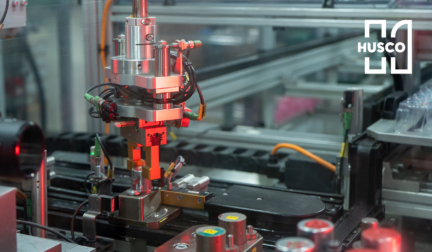How to Leverage Smart Manifold Design for Ultimate Machine Performance
The hydraulic controls in off-highway vehicles and access equipment provide operators with easier operation and more precise control than ever before. If an operator can lift a boom faster or position a bucket more accurately, productivity goes up and costs go down – something every machine operator wants to see.
Designing the perfect manifold — which contains the circuit that regulates how much fluid flows between the pumps and actuators — can be complicated because there are many options to consider. Manifolds can be produced by machining solid bar stock, or as customized castings. Each option has its own benefits.
Manifold Considerations
Manifolds produced from solid bar stock are machined with a series of drills and port tools to meet the needs of an original equipment manufacturer (OEM) application quickly and relatively inexpensively, they are typically used in low volume, low cost applications. Cast manifolds are often used in higher volume applications where a customized geometric shape may be needed, however they also require higher tooling costs and more development time. Cast manifolds have less flexibility for changes once the tooling is made, while manifolds machined from bar stock have a much higher level of flexibility for changes to machined features.
To help OEM’s choose a manifold valve design that delivers the best results possible, HUSCO has deep system knowledge of hydraulic controls, user applications, machine functions, as well as extensive design expertise for either cast manifolds or manifolds machined from bar stock. Having a wider variety of options available makes HUSCO an ideal partner for OEM’s looking for more efficient and cost effective system performance.
While most hydraulic component manufacturers specialize in either manifolds machined from bar stock or cast manifolds, HUSCO’s expertise in both product design types means there is no constraint in creating the best solution for an OEM’s special needs. HUSCO has the ability to design a hybrid of the two manifold design types, which can help in applications that have limited space or when a custom hydraulic circuit is required to optimized operation and performance of a vehicle.
Understanding the Application
To design and manufacture a manifold valve that will perform at the highest levels, the first step is to analyze how the OEM’s machine will be used. Will it have a high duty cycle or a low duty cycle? What function loads or pressure spikes should be expected? What type of multi-function harmony is required? What environments will the machine operate in? What function speed is required? HUSCO engineers understand how different off-highway machines operate, how operators use them, the varied functions of the machine and how smoothly everything should work together.
For example, the boom and extend functions on a telescopic boom lift have significantly different requirements in terms of kinematics, load pressures and function speeds. A manifold valve design needs the correct EH cartridge valves and hydraulic circuit logic elements to accommodate the range of flow rates and load pressures the system will encounter.
HUSCO recently worked with a customer that required a specific product to control the steering and brake functions on their machine that would also fit into a very tight space. The circuit required a combination of spools and EH cartridge valves to meet the system requirements. One option was to manufacture multiple manifold valves, which would increase the number of components requiring assembly on the vehicle assembly line and potentially impact machine performance consistency.
Instead, HUSCO designed and manufactured a hybrid solution that combined all of the circuit elements into a single customized valve assembly that met the tight space constraints. The single valve assembly greatly streamlined the OEM’s assembly process and reduced the number of plumbing connections and hydraulic components needed.
Experienced Custom Design
A common pitfall for an OEM is to rush an innovative new machine to market by defaulting to an existing schematic for a hydraulic circuit. A schematic only shows the paths and connections to each solenoid and valve element. As an innovation partner, HUSCO engineers work closely with the OEM’s engineers to review the system schematics, asking questions such as: how the machine will be used? how far the pump is located in relation to the manifold valves? or how the reservoir is positioned in relation to the manifold valves? System reviews help to ensure that the manifold design has the optimal set of valve elements and that internal passages inside the manifold housing are sized correctly to deliver enough oil to each function in the circuit during all operating conditions.
A custom manifold design can provide consistency in operator experience, minimized heat generation, minimized noise and vibration, with increased efficiency and productivity. This allows the machine performance to be optimized without a major development cost.
In a different example, another OEM came to HUSCO with a unique request for a number of different combinations of hydraulic valve assemblies. They required ten different hydraulic circuits to cover the range of options for their family of machines. HUSCO’s engineers came up with a modular design approach, with optimized manifold blocks that could be bolted to each other in multiple combinations to meet the customer’s various system requirements. The design solution met the OEM’s pressure, flow and circuit requirements, with a product that was simple to assemble and cost effective.
HUSCO works closely with OEM’s to provide manifold valve designs that combine all the right circuit elements into a single solution and to optimize machine performance and productivity, increase efficiency and reduce costs. HUSCO works side-by-side with OEM’s to solve hydraulic challenges and design manifold valves that help define the next industry-leading off-highway vehicle.
Contact us at HUSCO.com to find out how we help increase your hydraulic performance, accuracy and productivity.



